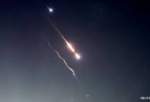The test on Monday saw a Ground-based Midcourse Defense (GMD) system, designed to counter intercontinental ballistic missile (ICBM) threats, successfully intercept and destroy its designated target, the US Missile Defense Agency (MDA) said in a statement.
During the test, which was a first for the GMD since its first live-firing in 2017, the system attempted a salvo engagement, firing two interceptors intended to strike an ICBM-level target fired from 4000 miles away.
“This test was the first salvo engagement of a threat-representative ICBM target by two Ground Based Interceptors (GBI), which were designated GBI-Lead, and GBI-Trail for the test,” the MDA’s statement read.
The ICBM target was launched from the Reagan Test Site on Kwajalein Atoll in the Republic of the Marshall Islands, while the two interceptors were launched from Vandenberg Air Force Base, California on Monday morning.
“The GBI-Lead destroyed the reentry vehicle, as it was designed to do. The GBI-Trail then looked at the resulting debris and remaining objects, and, not finding any other reentry vehicles, selected the next ‘most lethal object’ it could identify, and struck that, precisely as it was designed to do.”
MDA Director Air Force Lt. Gen. Samuel A. Greaves called the test a “critical milestone” for the US missile defense forces.
“The system worked exactly as it was designed to do, and the results of this test provide evidence of the practicable use of the salvo doctrine within missile defense,” he continued. “The Ground-based Midcourse Defense system is vitally important to the defense of our homeland, and this test demonstrates that we have a capable, credible deterrent against a very real threat.”
Despite the US claims of success, the GMD has a patchy trial record with 11 successful interceptions out of 19 attempts.
While it has been noted in the past that the $67 billion missile defense system is designed to defend the US mainland against possible missile attacks by North Korea, the recent test and its timing seems to convey a very different message.
The GMD’s first live-fire test came in 2017, shortly after North Korea launched an ICBM with an estimated range of 13,000 kilometers, enough to reach Alaska.
Putin said back then that America’s plans to deploy the GMD and other missile defense systems in Alaska and South Korea pose a threat to Russia.
“This destroys the strategic balance in the world,” Putin told a meeting with international media.
“What is happening is a very serious and alarming process. In Alaska, and now in South Korea, elements of the anti-missile defense system are emerging. Should we just stand idly by and watch this? Of course not. We are thinking about how to respond to these challenges. This is a challenge for us.”
The test comes after the US suspended the INF treaty, which bans deployment of land-based ballistic and cruise missiles with a range of 500 to 5500 kilometers. Trump said he would pull out in August if Russia doesn’t comply with the agreement.
Washington has been claiming for over six years that Russia’s new 9M729 ground-launched cruise missile (GLCM) violates the agreement.
Pentagon confirmed recently that it would test a new GLCM and a medium-range ballistic missiles later this year as a response.
Russia has denied US claims about the 9M729 missile and said it would also halt the INF and leave it unless the US stops its violations of the deal.
Moscow has claimed in the past that some American missile defense systems can also fire cruise missiles and their deployment could amount to a violation of the INF.
The administration of former US President George W. Bush had planned to set up a GMD site in Romania but his successor, Barrack Obama, scrapped those plans and deployed an Aegis-based missile defense system to Eastern Europe instead.
The Bulletin of the Atomic Scientists confirmed in a report in February that the Aegis would indeed violate the INF if armed with cruise missiles.
The Russian have also objected to America’s use of targets for missile defense tests that have similar characteristics to intermediate-range missiles prohibited under the INF.
John Bolton, Trump’s national security adviser, said last week that the US was “looking at strengthening our national missile defense system” to counter a growing threat from China.
While he did not specifically name Russia as a threat, Bolton’s statement blatantly contradicted the Trump administration’s 2019 Missile Defense Review claim that Russian and Chinese ICBMs were not the targets of GMD interceptors.
The review sticks to the original line that Washington relies on “deterrence” to counter Russian and Chinese ICBMs because any step towards developing a new missile defense system with that objective would trigger an arms race.
Trump has also raised questions about Washington’s real plans for new missile defenses.
Upon unveiling the missile strategy, Trump said he wanted to “ensure that we can detect and destroy any missile launched against the United States any time, any place.”
Russia and China have both expressed concern in the past that the American missile defense radars deployed to other countries could double function as an intelligence gathering tool.
KD








